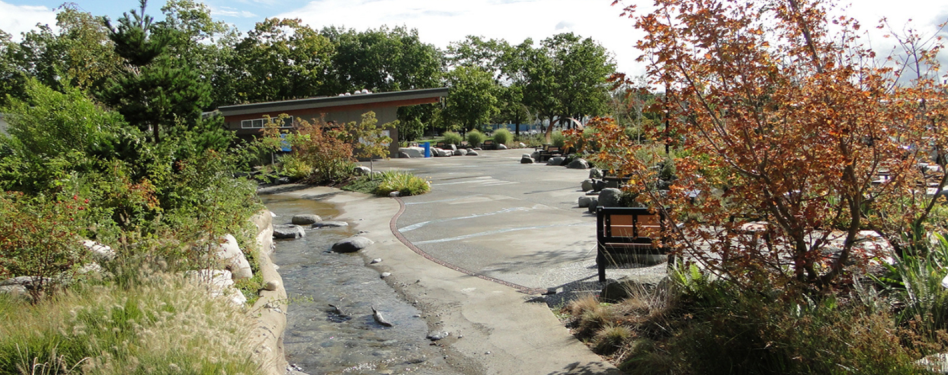
In April, the Sustainable SITES Initiative was included in the 18th Annual Water Conservation Showcase, a conference which brings together hundreds of advocates, researchers, business leaders, product manufacturers and government officials to address the most pressing water issues and challenges facing the state of California - and beyond. “SITES was invited because we recognize that a multi-benefit approach to water conservation is needed to help restore the environment and mitigate the effects of climate change. Conservation is one part of many different actions to deal with uncertainties in the future,” says Jolene Bertetto, the East Bay Municipal Utility District Water Conservation Representative who also moderated the session. “The goal is for integrated solutions, and landscapes are critical because outdoor water use is a significant portion of total residential water use. SITES’ multi-benefit approach considers how a landscape can not only save water but also sequester carbon, reduce waste, promote biodiversity, and save energy needed for transporting, treating, and pumping water.”
I was honored to work with Jolene and present alongside Kate Lenahan from CMG Landscape Architecture for our session titled “Climate Positive Landscape Design: Going Beyond Neutral”, which attracted over 200 attendees including sustainability consultants, architects, landscape architects, engineers, facility managers, among others. Highlighting the value of landscapes in our built environment, the session emphasized the potential of built landscapes in sequestering carbon, an important and necessary strategy to mitigate the effects of climate change. As Kate, who is based in California, noted during her presentation, “Strategies to reduce our carbon footprint include how we use water in landscape projects. In California, we’re very familiar with the limits on our water supply. With higher temperatures due to climate change, we know we’ll see longer and deeper drought.”
With concerted global action over the next decade (what the United Nations is calling, the “Decade for Ecosystem Restoration”), nature-based solutions can be a significant part of the climate solution, offering over one-third of the mitigation needed between now and 2030 to stabilize global temperature rise below 2°C. Many of these solutions also offer additional benefits such as water conservation, flood control, water quality improvements, habitat protection and enhanced climate resilience. In addition to sequestering carbon, our session focused on the myriad of ways to reduce carbon emissions in a development project. Available tools were also shared to help designers and others be more informed about their decisions in site design, material and plant selection, transportation, and construction and maintenance practices.
Kate opened the session by sharing why CMG and other collaborators created the Climate Positive Challenge and Pathfinder, a landscape carbon calculator that can show the impact site designs may have on local climate and community. After entering information about plants and materials, among other factors, the app lets designers and their clients know how many years their design will take to reach climate positive (i.e., sequesters more carbon than it emits). The app uses data derived from reputable sources such as the US Forest Service’s iTree database, manufacturer supplied Environmental Product Declarations and the ATHENA Impact Estimator for Buildings database. It also asks if you are pursuing LEED or SITES certification for your project. Rightfully, the Pathfinder App is getting much attention in recent years as it has filled an urgent need to understand and quantify the impact a landscape design may have in offsetting carbon or sequestering it. Climate Positive Design has set targets as part of its challenge, and the Pathfinder App provides an exciting and valuable tool for us to get closer to, and ideally, beyond climate neutral.
This work is also incredibly synergistic and complementary to the SITES Rating System as SITES is embedded with mitigation, adaptation, and resilience-based strategies and metrics. It includes credits that promote carbon sequestration like conserving existing natural systems, restoring soil, optimizing biomass (e.g., trees, shrubs, grasses), and restoring native habitat. SITES also promotes strategies that reduce carbon offsets like selecting low embodied carbon materials, reducing water use outdoors, promoting electric and fuel efficient equipment during construction and maintenance, using renewable energy, and much more. The rating system addresses carbon at every stage of the development process from pre-design through maintenance. It is important to recognize SITES’ foundation in ecosystem services and its intent to build a movement that transforms development practices and the market toward a more restorative culture - one that connects design with ecology and people to place. The SITES Rating System is a mechanism to celebrate leadership and propel this important work forward pushing professional practice and the industry toward climate positive design. SITES certified projects are high performance landscapes that bring meaningful experiences with nature back into our communities and cities, showing a future that is possible today.
The SITES Rating System is truly a living document that will continually evolve over time as research and experience generate more knowledge. To that end, I have been working with Pamela Conrad, also from CMG and founder of Climate Positive Design, and the LEED team to develop a pilot credit that quantifies carbon in landscape designs referencing the Pathfinder app and iTree. This credit is expected to be released later this year and available for use by both LEED and SITES projects. I believe SITES is more than a certification system; it is a means to build a global community of committed professionals and organizations. This includes working with organizations like CMG who recently joined as a SITES Community Partner, a program launched in late 2020 with the goal to collaborate on the evolution of SITES and join forces in our collective work toward a more regenerative and resilient future. We look forward to seeing more of you at events such as the Water Conservation Showcase, to support each other in our efforts to protect and regenerate our ecosystems and our homes.
If your organization is interested in becoming a SITES Community Partner, please visit here or contact us at sites@gbci.org.
